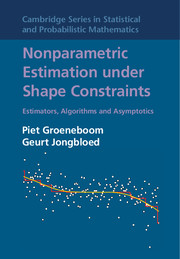Book contents
- Frontmatter
- Contents
- Preface and Acknowledgments
- 1 Introduction
- 2 Basic Estimation Problems with Monotonicity Constraints
- 3 Asymptotic Theory for the Basic Monotone Problems
- 4 Other Univariate Problems Involving Monotonicity Constraints
- 5 Higher Dimensional Problems
- 6 Lower Bounds on Estimation Rates
- 7 Algorithms and Computation
- 8 Shape and Smoothness
- 9 Testing and Confidence Intervals
- 10 Asymptotic Theory of Smooth Functionals
- 11 Pointwise Asymptotic Distribution Theory for Univariate Problems
- 12 Pointwise Asymptotic Distribution Theory for Multivariate Problems
- 13 Asymptotic Distribution of Global Deviations
- References
- Author Index
- Subject Index
3 - Asymptotic Theory for the Basic Monotone Problems
Published online by Cambridge University Press: 18 December 2014
- Frontmatter
- Contents
- Preface and Acknowledgments
- 1 Introduction
- 2 Basic Estimation Problems with Monotonicity Constraints
- 3 Asymptotic Theory for the Basic Monotone Problems
- 4 Other Univariate Problems Involving Monotonicity Constraints
- 5 Higher Dimensional Problems
- 6 Lower Bounds on Estimation Rates
- 7 Algorithms and Computation
- 8 Shape and Smoothness
- 9 Testing and Confidence Intervals
- 10 Asymptotic Theory of Smooth Functionals
- 11 Pointwise Asymptotic Distribution Theory for Univariate Problems
- 12 Pointwise Asymptotic Distribution Theory for Multivariate Problems
- 13 Asymptotic Distribution of Global Deviations
- References
- Author Index
- Subject Index
Summary
In Chapter 2 a number of estimation problems were introduced where monotonicity of functions can be taken into account in the estimation process. In this chapter asymptotic properties of monotone estimators will be derived. In Section 3.1 various methods for proving consistency of monotone estimators will be described. In Section 3.2, the pointwise limit behavior of the Grenander estimator will be derived heuristically. In particular, the typical rate of convergence of the estimator, n−1/3, will emerge from heuristic calculations. In order to make the heuristics rigorous in concrete problems, properties of (the derivative of) convex minorants of functions are needed. Important properties, especially the switch relation, will be reviewed in Section 3.3. The empirical process theory needed to make the convergence of certain processes precise is introduced in Section 3.4. In Section 3.5, empirical process theory is applied to derive the asymptotic distribution of the isotonic inverse estimator in a deconvolution problem defined in Section 2.4. Using the switch relation of Section 3.3 and empirical process results from Section 3.4, the pointwise asymptotic distribution of the Grenander estimator is rigorously derived in Section 3.6. An alternative approach to settle the asymptotic distribution theory proceeds via the theory of martingales. Section 3.7 states some important results from that theory. Using these results, in Section 3.8 local asymptotic properties of the maximum likelihood estimator in the current status model are derived. Various limit distributions are encountered in this chapter, related to convex minorants of processes related to Brownian motion. One of these, the Chernoff distribution, is discussed in Section 3.9. In Section 3.10 results on the concave majorant of Brownian motion and Brownian bridge are stated and discussed.
Consistency
In this section, some general methods are discussed that can be used to prove consistency of nonparametric estimators in monotone estimation problems. The first is rather direct. It is based on the explicit construction of estimators as derivative of a convex minorant of a random set of points.
- Type
- Chapter
- Information
- Nonparametric Estimation under Shape ConstraintsEstimators, Algorithms and Asymptotics, pp. 47 - 86Publisher: Cambridge University PressPrint publication year: 2014

